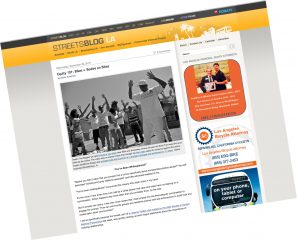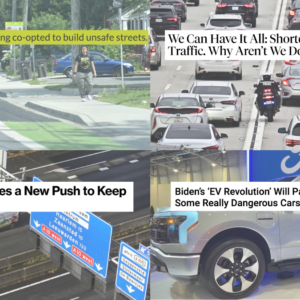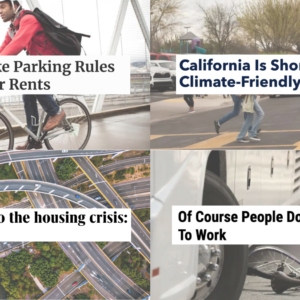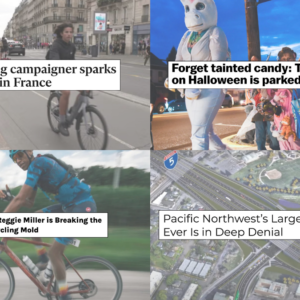Before we get started on this week’s best links from around the web, we want to give a special thanks to the Handmade Bike & Beer Festival for their advertising support and sponsorship of the Monday Roundup. The fest, now in its 9th year, happens this Friday and Saturday (10/7-8) in north Portland. Join me at the Base Camp Brewing tent to sample the fresh hop ale made with hops we picked up by bike!
Now, on with the best stories we came across this past week…
Terminator privilege: When it comes to selective enforcement, there’s white privilege and then there’s celebrity privilege. When movie star Arnold Schwarzenegger got stopped for cycling in a train station he got away scot-free by promising to take a selfie with the cop.
Commuting gift: Police in southern California met a teen who walked five hours to work — so they bought him a bike.
Bodies on bikes: Streetsblog L.A. writer Sahra Sulaiman has this week’s must-read on equity. It’s about the imperative need for mobility advocates to shift away from a bike-centric perspective and replace it with one that puts human existence and experience — what she calls the bodies on the bikes — at the top. Oh, and don’t dismiss racial justice when discussing transportation policy.
Cafe on wheels: We get a lot of pitches for bike-related crowdfunding campaigns. This one stood out for its impressive ambition about what a bike-based business can be: a turnkey cafe!
Zero vision, zero access: A proposal from the mayor of London would rate large trucks for safety (based on how well the driver can see other road users) and ban the most dangerous ones from entering the city center.
Driving is for old people: Like it or not we’re entering a new era of driving. Here’s an interesting perspective from young kids who might grow up to never know a world where humans got behind the wheel.
Counting what counts: Our friends at City Observatory put Placemeter, a new road user counting technology, to the test. Their verdict: It looks very promising.
Transit in LA: This seems like good news. A light rail line that goes between downtown Los Angeles and Santa Monica has been such a smash hit (reaching 70% of its ridership level) that new cars are being added to deal with overcrowding.
Advertisement
Expanded distraction enforcement: 10 years after California passed its first law to battle cell phone use while driving they have now widened the reach of the law.
When infrastructure expansion is good: In New York City a new policy proposal would allow the DOT to expand sidewalks in order to handle the human congestion.
When infrastructure expansion is bad: Then there’s the Oregon DOT, which celebrates the overdue completion of a project that cost $365 million just to straighten 10 miles of a little-used rural highway.
Paris FTW: Paris is the New York City of Europe. They’re not afraid to enact real car control measures. When Paris closed two miles of waterfront highway along the Seine River, it turns out people just figured out other — non-driving — ways to get around. Imagine that!
Progress in NYC: New York City Mayor Bill De Blasio signed several new laws into the books that make his city a nicer place to walk and bike.
Drugged up racers: We’re not sure what was more disturbing; this Deadspin headline about pervasiveness of drug use in the pro cycling ranks, or the tweet about it by former pro Ryan Trebon.
Inspiration from Groningen: Don’t believe the hype that cars are a necessity in dense urban environments. If you need a pick-me-up after battling haters, check out this profile of Groningen and have your faith in bicycling restored.
Change culture, change streets: Here’s a good overview on why car-centric countries like the US and the UK got that way, why it’s so harmful, and how we can start working toward a different reality.
Thanks to readers Paul, Todd, Mark, Steve, Ron and Ted for the suggestions this week.
— Jonathan Maus, (503) 706-8804 – jonathan@bikeportland.org
BikePortland is supported by the community (that means you!). Please become a subscriber or make a donation today.






Thanks for reading.
BikePortland has served this community with independent community journalism since 2005. We rely on subscriptions from readers like you to survive. Your financial support is vital in keeping this valuable resource alive and well.
Please subscribe today to strengthen and expand our work.
Love the banning dangerous trucks article. I would start with trucks without front right fender mirrors that give them a “dead” spot next to the cab. I would then move on to “lifted” pickup trucks. These are ridiculous, as trucks like this leave the factory with a semblance of legal height bumpers etc., then yahoos jack them up to feed their egos and make them much more dangerous in the case of even a low speed collision with a pedestrian or cyclist. If nothing else, change the law so that drivers injuring or killing vulnerable road users with dangerous vehicles ( not meeting current d.o.t pedestrian safety standards) are guilty of assault with a deadly weapon. And are are subject to all the criminal and civil penalties that go with it.
in Oregon there’s no such thing as a legal height bumper as there are no laws restricting height… same with headlights… you could mount your bumper and headlights at 7′ tall and still be legal…
mudflap requirements are about the only vehicle accessory law there is…
we’re seriously lacking in vehicle equipment laws…
Nice piece on the challenges trucks (lorries) have seeing cyclists. A pretty balanced presentation of the perspective from the drivers seat.
https://www.youtube.com/watch?v=6ofpj6L6nxg
“[E]xperts have warned that adding more capacity doesn’t always cut down on overcrowding; it may simply lead more people taking the train, which defeats the original purpose of adding more room.”
For the money they could’ve permanently solved all of their problems by adding two, maybe even three lane-miles of freeway instead…
It would be a shame for transit to become a victim of its own success. Should it happen, however, I think we’ve learned from the better part of a century of history with the alternative. Just ask any California transplant (you’re probably sitting next to one).
Usually it takes at least four miles of new highway to adequately replace a transit line.
This is a pretty weird thing to say, makes me wonder who those experts were. Induced demand is well-established, the only question is if you want to add more car traffic or increase transit ridership.
Yeah, that doesn’t sound so much like a “warning” as it does “good news! adding more train cars will increase ridership!”
thanks
One of my friends saw Arnold teaching his kid to ride a bike many years ago. Overheard Arnold quote to go in the pantheon:
“PEHDAL FAHSTAAA!”
Progress in NYC: yes please! there’s no point in having a count-down timer on the walk signal if we’re not allowed to enter the crosswalk during it, provided we can still make it across before 0… they added the timers and never adjusted the law to reflect their new use…
I seem to be noticing recently that more of ours have the countdown display turned off (and more pedestrians ignoring them.)
“…if we’re not allowed to enter the crosswalk during it, provided we can still make it across before 0…” spiffy
Some time back, in one of his columns, Joseph Rose, the guy that was writing for the O, asked somebody with the police, whether it was legal for people on foot to enter the crosswalk after the countdown started. The police person said it wasn’t legal. Take a look at the relevant Oregon law, which as I recall says it’s illegal to enter the crosswalk on a solid red light. I think an interpretation that’s valid here, is that during the flashing red countdown, it’s not illegal for people on foot to enter the crosswalk.
It takes maybe one crossing with a countdown crosswalk signal, for individual persons to know how many seconds it will take them to make a crossing within the allotted time.
Recall when traffic lights were accompanied by signs that read, “Signals set at 25mph” (or whatever the setting happened to be). Countdown clocks on ped signals should have signs that say “Countdown clock set at 60 seconds” (or whatever it’s set for). In many cases, the time you get is too short to get across safely. The Springwater Trail crossing at Foster Rd., a busy street crossing a trail section often used by kids and parents, was set at 15 seconds the last time I was there. Many impatient Happy Valley-bound motorists have been known to rev engines at folks crossing the street there. They don’t like that X-walk there, treating Foster as if it were their own private freeway. Countdown clocks should be prominent and set correctly for crossing traffic and width of the road. 60 seconds preferred.
Funny, how some people thing 7.5 miles is too far to bike. Because they think biking is the same as walking? It’s cool that the police pitched-in to get him a bike, but sad that this is a random act of kindness rather than city/state/national policy with employer/insurance providing/subsidizing the bike. Even riding an electric bike to work instead of driving will pay for itself in less than a year. But that’s cheating, right? I call it math. Math is cheating.
Kid walks to work – gets a bike: I Googled his hypothetical commute route to a local packing plant and the transit service was not very non-office worker friendly…it took him from Vallejo across the bay near Concord then back across the bay then back to the Benicia industrial area it passed on the second leg of the trip…crazy broken transit-jobs link.
I have to take issue with how you’ve characterized the Hwy 20 project. Yes, the designers failed to identity and account for the historic landslides in the project area which led to massive cost overruns, as did the poor performance of the initial contractor. It is a mischaracterization, however, to dismiss it as a mere straightening of a little used highway. Hwy 20 far from a little used highway, as it connects Newport and the central coast to I-5. Data also indicated that it was among the most dangerous in the state for drivers prompting the project, which was the largest road construction project in Oregon since I-205 was built.
Vision Zero applies to driver as well as cyclists.
I think he meant little used by privileged Portland bikers …
Privileged: having special rights, advantages, or immunities
I believe Jonathan is quoting the article, rather than calling it that himself.
If you read the comments on the article, the author responds to someone who had the same issue as you:
“Or as the state OTC member, Achterman, said, “low-usage.” That sentence explicitly pertains to the the funding decision (made years ago, when usage was less). More importantly, it comes in the larger context of the level of spending involved as well as the traffic volumes of larger roads. That said, I added the word “relatively” to make that more clear.”
Personally, I feel that spending $61 million per mile for 10 miles of highway is absolutely ridiculous and certainly worthy of greater scrutiny.
Jonathan makes a statement of fact: “When infrastructure expansion is bad: Then there’s the Oregon DOT, which celebrates the overdue completion of a project that cost $365 million just to straighten 10 miles of a little-used rural highway.” He doesn’t say the newspaper said so.
Did you miss the part where I mentioned the massive cost overruns due to poor design and performance? There is plenty to criticize without mischaracterizing the impetus for the project as a boondoggle.
The project was originally budgeted at $150m, so the poor planning, design and initial construction cost taxpayers upwards of $210 million.
Actually there was not much of the alignment that was not identified as landslide. However, ODOT chose to go Design-Build and then not hold the low-bid engineer/contractor accountable for a design that did not address landslides.
However, consider this – for the cost of the project, the money could endow at least thirty state patrol positions to do nothing but patrol this section of road and enforce speed limits and escort cyclists.
Enforcement seams to be a dirty word, but it can be far more cost effective than the engineered “fix” that is so popular on this form.
Do you believe that now increased speeds and likely higher use will make it less dangerous road?
That project cost 6 times as much as the estimated value of Portland’s entire bike network.
If it was built like our bike network, parts would be repaved, parts would be a path through a landslide, and the bridges would simply be missing.
And US-20 is a national highway, linking Newport, OR with Boston, MA. Fixing the road is a must. It’s a tsunami evacuation route, too. True, the project took too long to build, but the result will be worth it.
Finally all those Bostonites will be able to drive to Newport! /s
This route isn’t going to help Tsunami evacuation either. People have 10 min to evacuate, it’s not like they’re going to get even close to the old hairpin turns in that timeframe.
Part of why this is “little used” is the length restriction on trucks going from Toledo, OR to Corvallis, OR.
As a truck driver who lives in Portland it is fairly common for me to get assigned to pick up a load of paper from the big Georgia Pacific paper mill in Toledo (just east of Newport). To legally get there I can’t simply drive down I-5 to US-20 in Albany.
I am required by law to route down 99W to Hwy-18 just north of Lincoln City, then drive down the 101 to Newport and backtrack to Toledo.
Exiting requires almost the same route except if I’m going south I get to drag my 75′ of truck and trailer through downtown Salem.
This section of Hwy 20 being realigned allows many trucks to not just save fuel and miles but gets them off of the sections of the 101 that are beautiful for bicycle tourists.
It won’t eliminate truck traffic on the 101 but it will help a lot. Don’t worry: you’ll still have the clueless RV drivers meandering randomly across multiple lanes to contend with. I’ll miss these guys the least.
Will this benefit Portland? Of course not. Will it benefit public safety having a few thousand tons of freight per HOUR driving through prime tourist country? Oh heck yeah.
In other words, the completed project stands to, or is hoped to make money for the state through increased business and commerce, that improvement to the road can be an aid to. Plus, as you noted, it’s possible that a straighter route to the mill via I-5 and Hwy 20 rather that 18, will reduce some of the use of 101 with trucks.
Biggest issue accounting for the project’s high cost, seems to be contractors or engineers initially failing to accurately asses the type of construction needed to sufficiently deal with the stability of the terrain over which the highway passes.
From what is documented in many videos and planning slideshows is that this project was going to be difficult no matter what. I’m not sure that they had any current or accurate assessments of the real geology they had to tackle. Step 1 was to figure out what they had got themselves into and some of that required digging anyway.
Aside from the seasonal time constraint making the construction window short there is the primary issue of stability of every bit of terrain they dug through.
Landslides are a function of angle of repose which in a “static” environment is modified by soil moisture: we obviously have more landslides when it is wet in Portland. Steeper slopes and more consistent rain make this area more challenging. Add in seismic vibration from even small <4.0 quakes to wet slopes and it’ll slide easy.
But to naysayers – consider this:
ODOT may have been trying to learn or create new techniques and technologies for dealing with the sort of landslide prone hills we have densely covered in roads here in the Metro area.
If they are going to have made mistakes, learning important lessons, this extreme and more challenging version of Portland’s terrain landslide and seismicity issues provides a low risk testing area.
This highway work benefits Portland in that they’ll be able to do it cheaper, better and faster when we need it…. Hopefully before the big quake.
I have to second JRB. Highway 20 between Corvallis and Newport is NOT lightly used; every time I’ve been on the road (cycling or in a car) it’s had more traffic than Hwy 6 or Hwy 18 has. OSU is ever expanding the marine science programs in Newport, which will not lighten traffic between Newport and Corvallis…
That said — biking (old) Hwy 20 all the way to the coast (instead of the much better backway through Nashville and Siletz– biked many times) was one of the worst cycle-touring decisions I’ve ever made; lots of twisties, lots of log trucks, lots of fast cars, no shoulder, and steep banks right against the fog line — no where to bail. Perhaps the new section of road has shoulders…
The new alignment definitely has shoulders and much better sight lines for being able to see what is ahead.
ODOT has a YouTube channel and this is their most recent video on the project: https://youtu.be/LxN5bXivnQY
In particular they are stressing what this is going to do for public safety through better EMS response times, safer road side stops for police and much improved business access for the Newport economy due to convenient I-5 access.
But are all of those things worth $325M?
That’s a lot of college educations. That’s bike infrastructure beyond your dreams in Portland. That’s how many well-funded schools?
Is it nice to have? Sure.
Was it the best use of that amount of money? Not sure.
The problem is that we in Portland have 51% blinders:
we think that because Portland Metro is the majority voting block for the entire state of Oregon that everywhere else that isn’t Portland Metro can go stick their head in a pig.
The rest of the state has transportation needs too.
Oddly bicycle modes are not conflicting but come secondary to lifting 19th century era road conditions into the 21st century.
No. Really. Some of these communities basically just need a little bit to be raised up from standards of living that seem almost 3rd world compared to Portland.
The state did not intend to spend $325M on the project; the budget was $95M. I lived near the project during this debacle (it was in the paper now and again), and as the linked article summarizes, the root cause for the massive cost overrun is due to the state undervaluing the project in the first place: choosing the lowest bidder (that did not take into account geology, potential problems, etc), which resulted in doing all the work at least twice. Whoopsies!
Summary for the “Lessons Learned”: when selecting the lowest bid, you get what you pay for.
I hit a deer on that stretch once (used to drive it frequently but never biked it; thought it was pretty dangerous as e2pii mentions). Thanks for the vid – brings back memories of dawn south jetty surf sessions after roadside camping and then driving back to my office in Corvallis where people would ask me why there was a wetsuit hanging on my van.